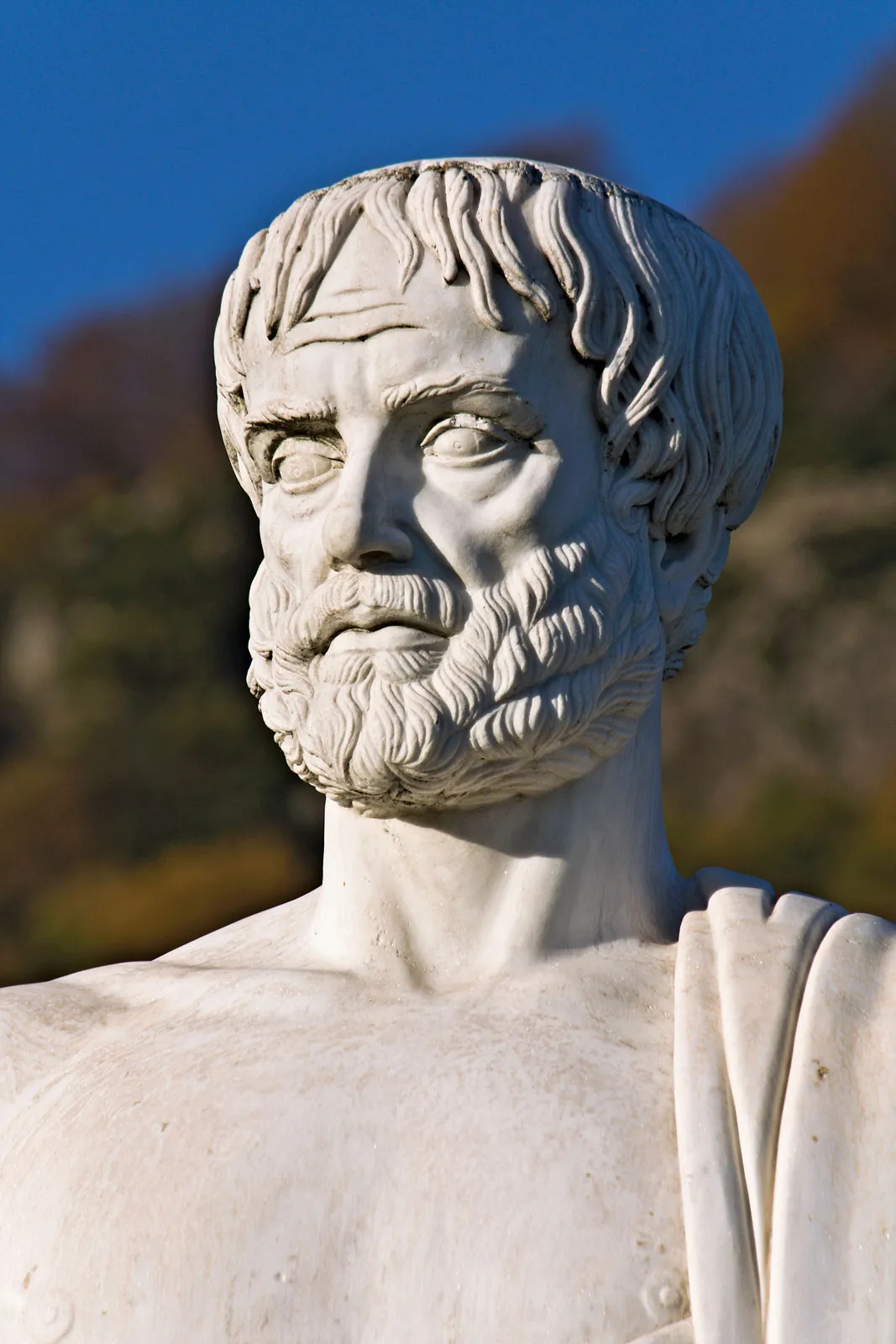博文
[资料,科普] 亚里士多德的“四因说 four causes hypothesis” four types of cau
||
[资料,科普] 亚里士多德的“四因说 four causes hypothesis” four types of cause

图1 亚里士多德 Aristotle, Aristoteles, 384 BCE ~ died 322, 62
Aristotle-Stagira-Greece.webp
https://cdn.britannica.com/70/145570-050-6C571884/Aristotle-Stagira-Greece.jpg
https://www.britannica.com/biography/Aristotle
以下对应英文的汉语,来自机器翻译。
机器翻译的某些术语,有待您进一步自行核对。
亚里士多德认为原因有4种不同的类型:
质料因 material causes,即一个事物从之而来的材料,或构成一个事物的成分、元素,例如铜是一个铜制雕塑的质料因;
形式因 formal causes,即一个事物的定义或本质,例如雕塑的形状是它的形式因;
动力因 efficient causes,即一个事物由以变化运动的动力,例如雕塑家是雕塑的动力因;
目的因 final causes,即一个事物的目的,例如雕塑家制作雕塑的是为了装饰房间,装饰房间就是这个雕塑的目的因。
https://plato.stanford.edu/entries/aristotle-causality/
The material cause or that which is given in reply to the question “What is it made out of?” What is singled out in the answer need not be material objects such as bricks, stones, or planks. By Aristotle’s lights, A and B are the material cause of the syllable BA.
在回答“它是由什么制成的?”这个问题时给出的物质原因不一定是砖块、石头或木板等物质。根据亚里士多德的观点,A和B是音节BA的物质原因。
The formal cause or that which is given in reply to the question “"What is it?”. What is singled out in the answer is the essence or the what-it-is-to-be something.
在回答“它是什么?”的问题时给出的正式原因。答案中指出的是本质或它是什么。
The efficient cause or that which is given in reply to the question: “Where does change (or motion) come from?”. What is singled out in the answer is the whence of change (or motion).
在回答“变化(或动议)从哪里来?”的问题时给出的有效原因。答案中特别指出的是变化(或运动)的来源。
The final cause is that which is given in reply to the question: “What is its good?”. What is singled out in the answer is that for the sake of which something is done or takes place.
最后一个原因是对“它有什么好处?”这个问题的回答。答案中特别指出的是,为了什么而做或发生某事。
https://plato.stanford.edu/entries/aristotle-causality/
参考资料:
[1] 2023-09-09,四因说/four causes hypothesis/邬焜,中国大百科全书,第三版网络版[DB/OL]
https://www.zgbk.com/ecph/words?SiteID=1&ID=408872&Type=bkzyb&SubID=202991
[2] 2022-01-20,原因/causes/曹青云,中国大百科全书,第三版网络版[DB/OL]
https://www.zgbk.com/ecph/words?SiteID=1&ID=208975&Type=bkzyb&SubID=102013
在希腊文的日常语义中,“原因”(αἴτιαι)指为某物或某物的状态负责。前苏格拉底时期,哲学家们多将“原因”理解为时间上在先的、产生一个事物的物理原因,而柏拉图从逻辑和本体论的角度将“原因”理解为存在上在先的、确保一个事物本质的东西。亚里士多德结合了这两种倾向,并认为“原因”不仅是时间上在先的起源,而且是存在上在先的本质。他认为只有人们了解了一个事物生成和存在的原因时,才真正地拥有了这个事物的知识。
[3] Aristotle on Causality, 2023-03-07, Stanford Encyclopedia of Philosophy
https://plato.stanford.edu/entries/aristotle-causality/
[4] Aristotle, Greek philosopher, britannica
https://www.britannica.com/biography/Aristotle
Also known as: Aristoteles
In several places Aristotle distinguishes four types of cause, or explanation. First, he says, there is that of which and out of which a thing is made, such as the bronze of a statue. This is called the material cause. Second, there is the form or pattern of a thing, which may be expressed in its definition; Aristotle’s example is the proportion of the length of two strings in a lyre, which is the formal cause of one note’s being the octave of another. The third type of cause is the origin of a change or state of rest in something; this is often called the “efficient cause.” Aristotle gives as examples a person reaching a decision, a father begetting a child, a sculptor carving a statue, and a doctor healing a patient. The fourth and last type of cause is the end or goal of a thing—that for the sake of which a thing is done. This is known as the “final cause.”
[5] 2022-01-20,密尔求因果五法/Mill's five methods in searching of causal connections/徐孝通,杜国平,中国大百科全书,第三版网络版[DB/OL]
https://www.zgbk.com/ecph/words?SiteID=1&ID=216822&Type=bkzyb&SubID=104156
契合法、差异法、契合差异并用法、剩余法和共变法(密尔本人没有把契合差异并用法作为一种独立于其他种方法之外的方法,所以他的提法是“实验研究四法”)。
[6] 2022-01-20,密尔五法/Mill's five methods/韩冬临,中国大百科全书,第三版网络版[DB/OL]
https://www.zgbk.com/ecph/words?SiteID=1&ID=111896&Type=bkzyb&SubID=99940
以前的《科学网》相关博文链接:
[1] 2021-12-18 19:46,[资料汇集] 判断因果性
https://blog.sciencenet.cn/blog-107667-1317132.html
[2] 2013-10-01 13:17,密尔求因果五法:《中国大百科全书》第一版、第二版
https://blog.sciencenet.cn/blog-107667-729352.html
[3] 2022-07-18 15:19,[小思考,大困惑] 不能仅从一组时间序列分析得到因果性?
https://blog.sciencenet.cn/blog-107667-1347796.html
[4] 2013-04-15 12:23,[请教] 物理基础:因果关系是否依赖观察者?
https://blog.sciencenet.cn/blog-107667-680338.html
[5] 2022-07-29 15:05,[随笔] 地震:前兆、预报与“因果性、相关性”杂谈
https://blog.sciencenet.cn/blog-107667-1349269.html
[6] 2025-07-29 21:11,[资料,科普,感慨] 布里丹之驴 Buridan's Ass
https://blog.sciencenet.cn/blog-107667-1495729.html
[7] 2025-07-23 21:39,[资料,科普,感慨] Heraclitus:没有人会两次踏入同一条河 No man ever steps in the same river twice
https://blog.sciencenet.cn/blog-107667-1494921.html
[8] 2025-07-21 21:42,[资料,科普,感慨] 忒修斯之船 Ship of Theseus
https://blog.sciencenet.cn/blog-107667-1494632.html
[9] 2025-07-09 22:09,[笔记] 柏拉图的“洞穴之喻” Plato's allegory of the cave vs 爱因斯坦的狭义相对论
https://blog.sciencenet.cn/blog-107667-1493072.html
[10] 2025-06-12 20:58,[科学,神话,想象力] 希腊神话里的赫菲斯托斯 Hephaestus 与 Parthenogenesis
https://blog.sciencenet.cn/blog-107667-1489577.html
[11] 2025-05-01 22:14,[笔记] 坦塔洛斯 Tantalus 的磨难:一个人所受的巨大磨难和人生挑战
https://blog.sciencenet.cn/blog-107667-1484230.html
[12] 2025-05-18 22:53,[无语,对照] 女武神 Valkyries 布伦希尔德 Brunnhilde vs 伽利略的“追求科学需要特殊的勇敢”
https://blog.sciencenet.cn/blog-107667-1486231.html
[13] 2025-05-04 22:38,[笔记,资料] 亚当斯写信给阿比盖尔:我的儿子们应该学习数学和哲学、地理、自然历史、造船、航海、商业和农业
https://blog.sciencenet.cn/blog-107667-1484501.html
[14] 2022-01-08 15:38,[求证] 古希腊文明与吃鱼有关系?
https://blog.sciencenet.cn/blog-107667-1320099.html
[15] 2025-07-31 21:06,[资料,打听] 牛顿家 Woolsthorpe Manor, Lincolnshire 房子上两个 S 是什么?有什么用途?
https://blog.sciencenet.cn/blog-107667-1496017.html
[16] 2025-08-08 20:32,[资料,科普,感慨] 物理运动 vs 社会运动:“南海泡沫”后的牛顿,不会计算人类的疯狂
https://blog.sciencenet.cn/blog-107667-1496995.html
[17] 2025-09-10 20:10,[资料,科普] 拉斐尔 Raphael 1508-1511年创作的湿壁画“雅典学院 School of Athens”
https://blog.sciencenet.cn/blog-107667-1501377.html
感谢您的指教!
感谢您指正以上任何错误!
感谢您提供更多的相关资料!
https://wap.sciencenet.cn/blog-107667-1501650.html
上一篇:[打听,科普,资料] 莫拉维克 Moravec 的“人类能力景观图”及其更多的同类资料 (关联:“自然运算”)
下一篇:[资料,图片] 一些蛋类:turkey 火鸡 duck 鸭蛋 rhea 美洲鸵鸟 goose 鹅 pheasant 野鸡